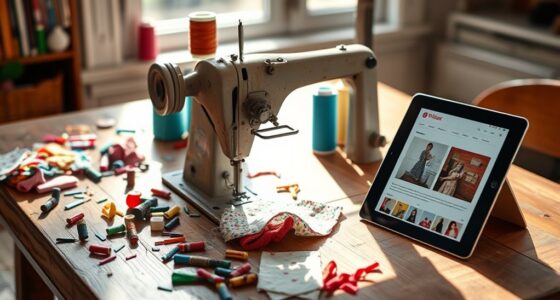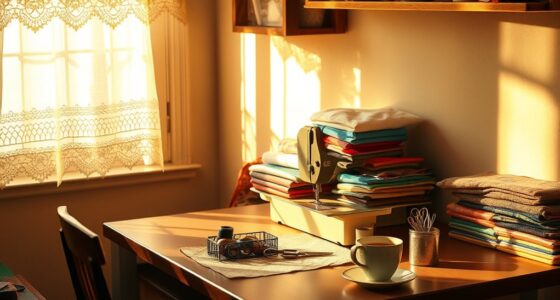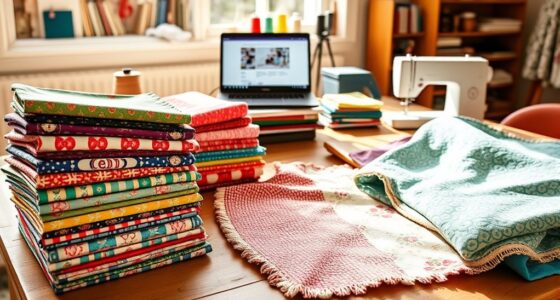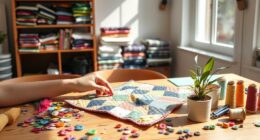To create a sustainable sewing room on a budget, repurpose old furniture by sanding, painting, or staining to add charm and reduce waste. Use natural materials like bamboo baskets or reclaimed wood for storage, and thrift for unique containers. Incorporate multifunctional pieces or open shelving to maximize space without costing too much. Focusing on eco-friendly choices and DIY projects helps you save money while supporting sustainability—keep exploring to find more tips for your eco-conscious sewing space.
Key Takeaways
- Upcycle existing furniture with sanding, paint, or stain to add character and reduce waste.
- Use natural, reclaimed, or repurposed storage materials like bamboo baskets and wooden crates.
- Incorporate vintage or thrifted containers and furniture for stylish, budget-friendly storage solutions.
- Focus on sustainable practices like mindful consumption and choosing durable, eco-friendly materials.
- Maximize space with multifunctional furniture and creative storage ideas that support eco-conscious living.
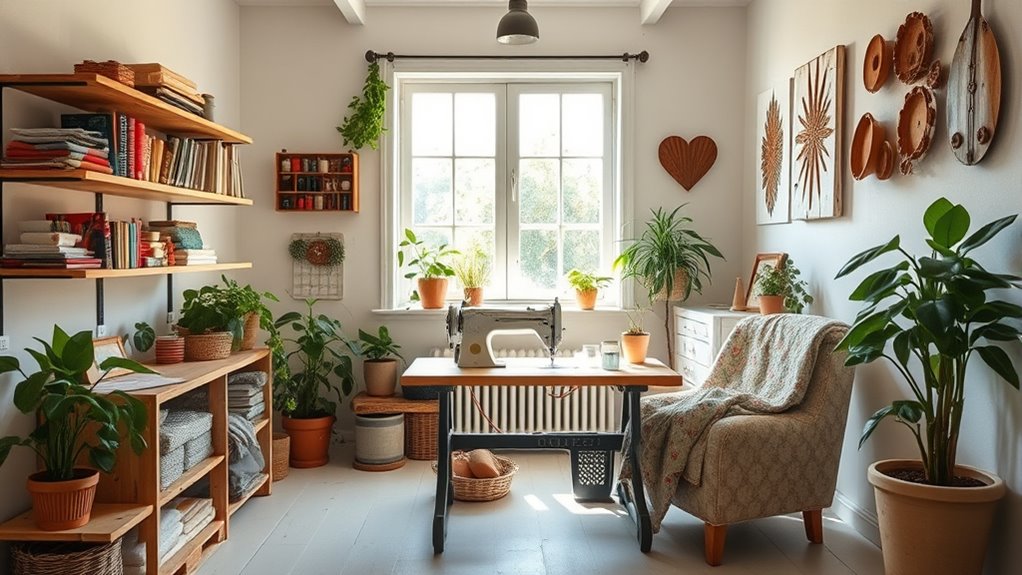
A sustainable sewing room makeover not only refreshes your workspace but also reduces your environmental impact. When you focus on eco-friendly choices, you can transform your sewing area into a functional, stylish space without breaking the bank. One of the most effective ways to do this is through upcycling furniture. Instead of rushing to buy new storage units or worktables, look around for old furniture that can be given a new life. An outdated wooden dresser or a tired side table can become a charming sewing station with a little sanding, paint, or stain. Not only does this reduce waste, but it also adds unique character to your space. Upcycling allows you to create custom storage solutions tailored to your needs, all while avoiding the environmental cost of manufacturing new furniture. Fokos can offer inspiration and tips for sustainable home projects like this.
Eco friendly storage is another key element of a sustainable sewing room. Traditional storage options often involve plastic bins or mass-produced shelves that contribute to environmental degradation. Instead, consider using natural materials like bamboo baskets or repurposed wooden crates. These options are often more durable, visually appealing, and sustainable. You can also explore DIY projects, such as converting cardboard boxes into storage containers with fabric covers or paint, giving them a fresh, personalized look. Open shelving made from reclaimed wood provides easy access to your supplies and keeps your workspace organized without the need for plastic organizers that may end up in landfills. By choosing eco friendly storage, you’re not only decluttering efficiently but also making an environmentally conscious decision.
Getting creative with your storage solutions can also save money. For example, repurposing vintage suitcases as storage for sewing notions or fabric scraps adds a touch of nostalgia while keeping clutter at bay. Thrift stores often carry unique containers and furniture pieces that can be upcycled for your sewing room. These options tend to be less expensive than new furniture and are often more durable because they’ve already stood the test of time. Additionally, investing in multifunctional furniture, like a table with built-in drawers or a fold-away sewing station, maximizes space and minimizes the need for extra pieces.
Creative storage ideas like vintage suitcases and multifunctional furniture save money and space.
Finally, remember that a sustainable sewing room is about mindful consumption. When you’re shopping for supplies or furniture, prioritize quality and longevity over trends. By choosing upcycled furniture and eco friendly storage, you’re making practical choices that benefit the environment and your budget. With a little effort and creativity, you can craft a sewing space that’s both inspiring and sustainable—one that reflects your values without compromising on style or functionality.
Frequently Asked Questions
How Can I Source Eco-Friendly Sewing Tools Affordably?
You can source eco-friendly sewing tools affordably by exploring upcycling fabric and repurposing old materials for your projects. Look for secondhand shops or online marketplaces for gently used notions like scissors, threads, and pins. Consider supporting brands that prioritize sustainable practices, but also keep an eye out for sales or discount bundles on eco-friendly notions. This way, you save money while making environmentally conscious choices for your sewing room.
What Are Some DIY Sustainable Storage Solutions?
You can create DIY sustainable storage by repurposing items you already have, like upcycled storage bins from cardboard boxes or jars. Use natural materials such as bamboo baskets or wooden crates to keep your space eco-friendly. Get creative by transforming old furniture into new storage solutions. These options are affordable, eco-conscious, and add charm to your sewing room, making organization both stylish and sustainable.
How Do I Choose Non-Toxic Fabrics on a Budget?
When choosing non-toxic fabrics on a budget, focus on natural dyes and organic cotton. Look for affordable options at local fabric stores or online shops that prioritize eco-friendly materials. Natural dyes can be made at home using plant-based ingredients, saving you money. Organic cotton is often more affordable than other sustainable fabrics, and it’s free from harmful chemicals. Prioritize these options to create a safer, eco-friendly sewing environment without breaking the bank.
Are There Any Low-Cost Ways to Improve Lighting Sustainably?
Think of your sewing space as a garden that needs sunlight. You can brighten it naturally by enhancing natural light with reflective surfaces like mirrors or light-colored walls. For a budget-friendly, sustainable boost, switch to energy-efficient bulbs, which sip power like a fine wine. These small changes make your workspace greener, saving money and energy while giving you a well-lit, inspiring environment to create in.
How Can I Repurpose Old Furniture for My Sewing Space?
You can easily repurpose old furniture by applying simple upholstery techniques to give pieces new life. Consider reupholstering chairs with eco-friendly fabrics or adding fresh cushions. Vintage furniture restoration also works well; sand and paint tables or shelves to match your sewing space’s style. These steps are budget-friendly, eco-conscious, and help create a cozy, sustainable sewing room that reflects your personality.
Conclusion
By choosing eco-friendly materials and repurposing what you already have, you can create a sewing space that’s both sustainable and inspiring. Imagine transforming an old bookshelf into a fabric organizer or using reclaimed wood for a cutting table—like Sarah did, saving money and reducing waste. With a little creativity, your sewing room can be a beautiful, eco-conscious haven that sparks your passion and benefits the planet. Start small, and watch your sustainable sewing space flourish!


